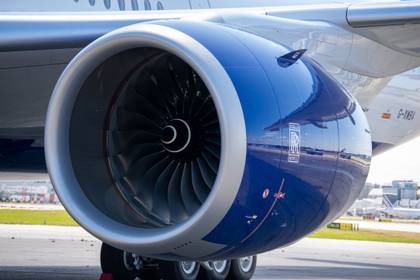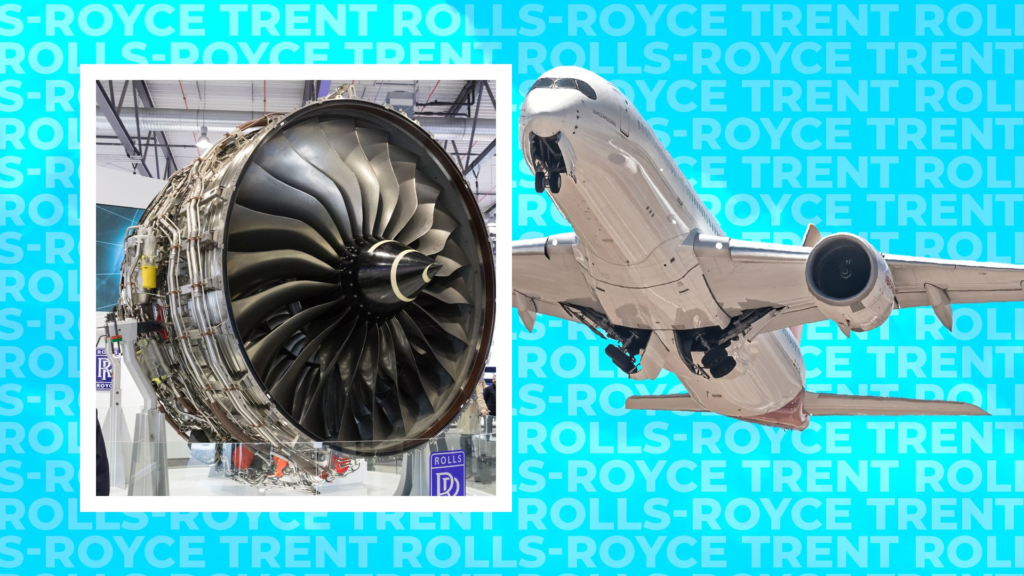Rolls-Royce has long been a key player in the evolution of modern aviation. Over decades, its engines have powered some of the most significant aircraft in commercial service and have shaped the fleets of major airlines worldwide. From the early RB211 series to the later Trent family, the UK-based engine manufacturer has consistently introduced new technologies that have set benchmarks in performance, efficiency, and reliability across long-haul markets.
The Trent series has become one of its defining achievements, supporting a wide range of widebody aircraft. Each generation has added new layers of technology and performance. The most advanced of these is the Trent XWB, which was developed as the sole powerplant for the Airbus A350. It was designed to deliver the combination of power, efficiency, and reliability that earlier widebody engines could not achieve.
How The Trent XWB Became Central To Airbus’ Long-Haul Strategy
The Trent family has been in service since the 1990s and is powering aircraft such as the Airbus A330, A340, and A380, as well as the Boeing 787 Dreamliner. With each generation, Rolls-Royce refined the design to deliver more thrust, better efficiency, and improved reliability. The Trent XWB was launched in 2006 as the newest member of the series and was developed exclusively for the Airbus A350. It received certification in 2013 and entered commercial service in 2015 with Qatar Airways.
By the mid-2000s, Airbus was under pressure from airlines to respond to the 787. The initial plan was to launch the A350 as an upgraded version of the A330, for which Rolls-Royce proposed a bleed-air variant of the Trent 1000 known as the Trent 1700. This engine would have delivered up to 75,000 pounds of thrust, but airlines were not convinced. Their demand for a more capable aircraft pushed Airbus toward a clean-sheet design.
In 2006, the European planemaker abandoned the derivative approach and committed billions to a new aircraft. To match its performance goals, the company turned to Rolls-Royce for a new powerplant. The result was the Trent XWB, designed exclusively for the A350 with thrust ratings between 75,000 and 95,000 pounds.
As Airbus refined the design and increased the aircraft’s maximum takeoff weight, the most powerful version was uprated to 97,000 pounds to meet range and payload requirements. This made the Trent XWB the most capable member of the Trent family, and also the most fuel efficient large engine Rolls-Royce had ever produced.
Why Rolls-Royce Prioritized A High Bypass Ratio For The A350
From the outset, the Airbus A350 required an engine capable of delivering at least a 15% improvement in fuel consumption over comparable aircraft from the previous generation. Specific fuel consumption had to be significantly lower than that of large turbofans then in service, including the GE90-115, Trent 900, and Trent 7000, while also meeting tighter noise standards demanded by regulators and airlines.
These requirements set a high technical bar, as no engine then available could provide the combination of efficiency, power, and reliability needed for the new aircraft. To meet this demand, Rolls-Royce developed the Trent XWB with efficiency as the guiding principle, and achieving a higher bypass ratio was central to that goal. The Trent XWB retains Rolls-Royce’s three-shaft architecture and incorporates a 118-inch fan with 22 wide-chord titanium blades.
|
Trent XWB Technical Details |
|
|---|---|
|
Configuration: |
Three-shaft turbofan |
|
Fan: |
22 blades, 118-inch diameter |
|
Intermediate Pressure Compressor: |
8 stages |
|
Bypass Ratio: |
9.6:1 |
|
Overall Pressure Ratio: |
50:1 |
|
High-Pressure Compressor: |
6 stages |
|
Noise: |
QC 0.5 departures/ QC 0.5 arrivals |
As a result, it has a bypass ratio of 9.6:1, meaning that for every unit of air passing through the core, 9.6 units are bypassed around it. This configuration moves a larger volume of air around the engine, which lowers fuel burn, cuts emissions, and reduces noise.
The Trent XWB is today the most efficient large aero engine in commercial service. According to Rolls-Royce, it consumes 15% less fuel than the first Trent engine and contributes to the A350’s 25% lower fuel burn compared with previous-generation widebodies.
Two Main Versions Of The Trent XWB And Their Applications
The Trent XWB family includes two primary variants: the XWB-84, which produces 84,000 pounds of thrust for the A350-900, and the XWB-97, which delivers up to 97,000 pounds of thrust for the larger A350-1000 and A350F. Both engines are externally almost identical, but the latter was developed to meet the A350-1000’s higher maximum takeoff weight of 696,661 pounds, compared with 617,295 pounds for the -900.
To provide the additional 13,000 pounds of thrust, Rolls-Royce increased the fan’s rotational speed by 6%. It scaled up the core to process greater airflow while operating at higher combustor and turbine temperatures. The XWB-97 entered service in 2018 as Rolls-Royce’s most powerful commercial engine to date.
|
Rolls-Royce Trent XWB-84 & XWB-97 Specification |
||
|---|---|---|
|
Specification |
Trent XWB-84 |
Trent XWB-97 |
|
Thrust Rating |
84,000 lbs |
97,000 lbs |
|
Weight |
16,043 lbs |
16,640 lbs |
|
Thrust-To-Weight Ratio |
5.25 |
5.82 |
|
Fan diameter |
118 inches |
118 inches |
|
Fan blades |
22 |
22 |
|
Bypass Ratio |
9.6:1 |
9.6:1 |
|
Overall Pressure Ratio |
50:1 |
50:1 |
|
Application |
A350-900/-900ULR |
A350-1000/A350F |
Alongside these, Rolls-Royce also developed the lower-rated XWB-75, originally intended for the smaller A350-800 that was later canceled. While that variant never entered wide production, the XWB-84 and XWB-97 continue to benefit from incremental improvements.
Most recently, Rolls-Royce introduced the Trent XWB-84 Enhanced Performance (EP) upgrade, which reduces fuel burn by at least 1%, equating to roughly $5 million in annual fleet savings. For the XWB-97, the manufacturer is developing new technology packages aimed at improving efficiency, extending on-wing life, and doubling durability even under the most demanding operating conditions.
Reliability And Operator Feedback On The Trent XWB
Rolls-Royce says the Trent XWB had the smoothest entry into service of any large commercial engine, with the first units now reaching their initial planned overhauls. The manufacturer notes that the engine has behaved exactly as expected through years of service.
Additionally, according to the company, Trent XWB has a 99.9% dispatch reliability rate, meaning the chance of a delay caused by the engine is almost negligible. Airlines largely echo this assessment. According to ch-aviation data, there are currently 539 A350-900s in active service, alongside nearly 100 A350-1000s and seven A350-900ULRs, all powered by the XWB.
Finnair, one of the earliest A350-900 operators, described the XWB-84’s entry into service as “very successful from an operational perspective.” Sara Mosebar, then A350 program manager at Finnair, told Aircraft Commerce in 2020 that while a few individual components required attention, these issues did not compromise safety or reliability.
In fact, the airline recorded performance improvements in service, with dispatch reliability averaging one operational interruption per 1,000 departures across the first four years. ![]() Iberia, which has operated the XWB-84 since 2018, also offers a similar view. With 23 A350-900s in its fleet and more on order, the airline has reported good dispatch reliability and generally trouble-free operations.
Iberia, which has operated the XWB-84 since 2018, also offers a similar view. With 23 A350-900s in its fleet and more on order, the airline has reported good dispatch reliability and generally trouble-free operations.
Rolls-Royce Is Planning To Push Efficiency Further With UltraFan
While the Trent XWB continues to perform well in service, Rolls-Royce is also preparing for the next generation of engines. The company’s UltraFan demonstrator, which was first tested in 2023, introduces technologies aimed at improving efficiency and meeting the demands of future widebodies.
UltraFan combines a geared fan system with a lean-burn combustor and advanced composite fan blades, offering a step change in efficiency. Rolls-Royce estimates the design delivers a 25% fuel-burn improvement compared to the Trent 700 and around 10% over the Trent XWB. With a 140-inch fan (the largest yet developed), the demonstrator is capable of generating more than 85,000 pounds of thrust while achieving a bypass ratio of up to 15:1.
Beyond efficiency, Rolls-Royce has designed the UltraFan as a scalable platform able to deliver between 25,000 and 110,000 pounds of thrust, allowing it to serve both narrowbody and widebody aircraft entering service in the 2030s. Airbus, which has been a partner in the program since 2018, is supporting integration studies and remains a likely candidate to adopt the technology on future long-haul types, with the A350 often cited as a strong fit.
UltraFan Points To The Future, But The Trent XWB Defines The Current Era
Indeed, the UltraFan is a promising program and will no doubt bring healthy competition to the market, but it is not expected to enter service until the 2030s. Rolls-Royce has positioned it as the next step in efficiency, scalability, and adaptability, yet for the foreseeable future, the Trent XWB will remain the company’s most advanced and widely deployed engine.
With more than 600 A350s in service across the -900, -1000, and ULR variants, the XWB has already set a high benchmark for fuel efficiency and reliability. Operators report strong dispatch reliability and even performance improvements in service, while the engine continues to undergo its first scheduled overhaul with results matching expectations.
As the UltraFan moves toward maturity, the Trent XWB will carry Rolls-Royce through the remainder of the decade, and anchor the A350 fleet worldwide while also shaping expectations for what comes next. It stands as both the centerpiece of today’s long-haul market and the foundation for the next generation of propulsion.

- Stock Code
-
RR
- Business Type
-
Engine Maker
- Date Founded
-
March 15, 1906
- CEO
-
Tufan Erginbilgic








